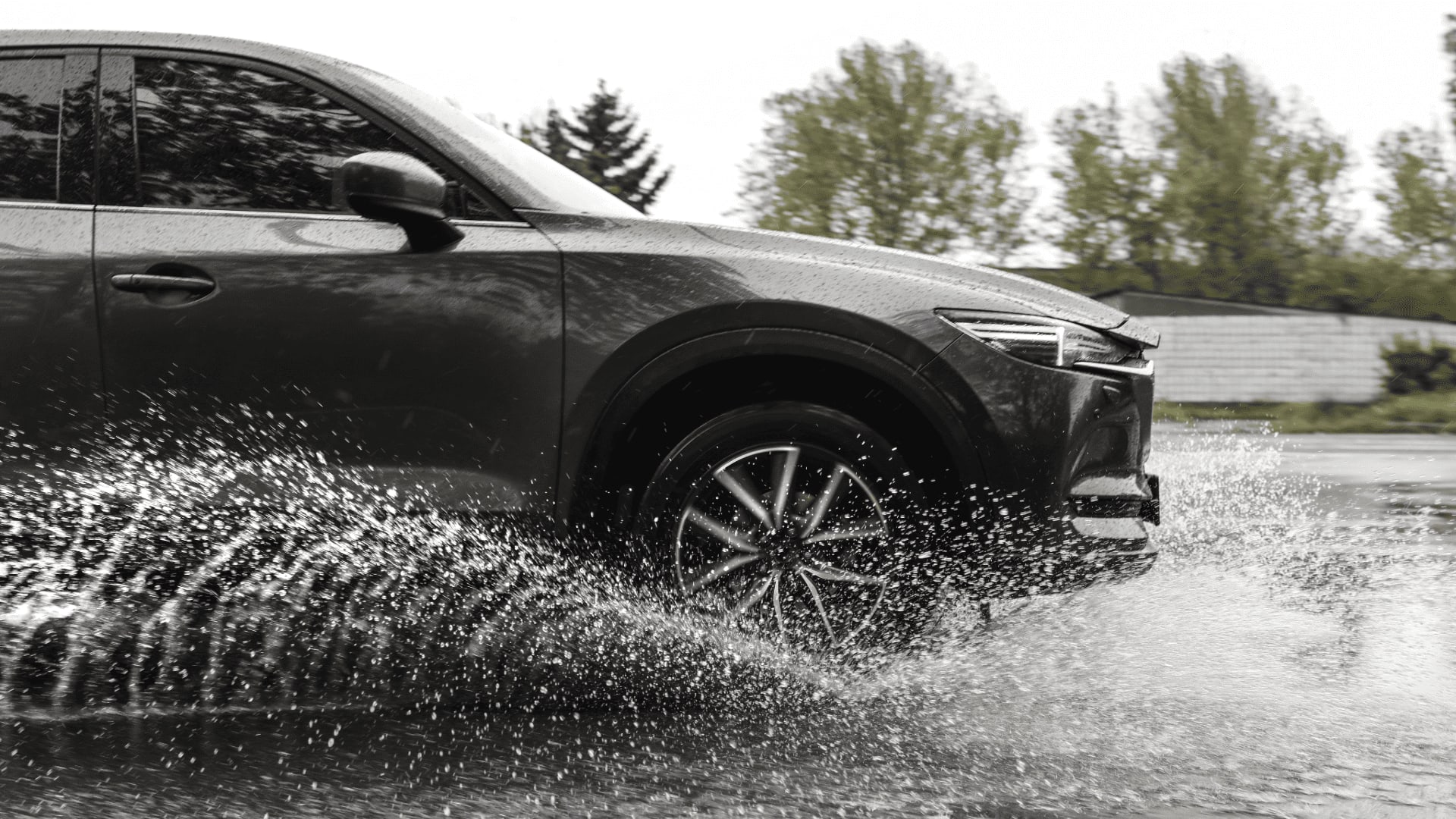Tire Maintenance & Safety
Best price guarantee
Tire replacement coverage
24/7 roadside assistance
Easy returns

Driving in the rain can be a nerve-wracking experience, especially when you feel your vehicle losing traction on the slick, wet roads. This unsettling sensation is often caused by a phenomenon known as hydroplaning, which occurs when your tires lose contact with the road surface and instead glide on a thin layer of water.
To help you stay safe and in control during rainy conditions, it's crucial to understand what hydroplaning is, how it happens, and what you can do to prevent it. By taking proactive measures and maintaining your tires properly, you can significantly reduce the risk of hydroplaning and ensure a safer driving experience for yourself and your passengers.
In this article, we'll dive into the basics of hydroplaning and provide you with practical tire tips to help you avoid this dangerous situation. From monitoring tire tread depth to adjusting your driving habits in wet weather, we've got you covered with expert advice to keep you safe on the road.
What is Hydroplaning?
Hydroplaning is a dangerous phenomenon that occurs when a vehicle's tires encounter more water than they can disperse, causing them to lose contact with the road surface and instead ride on a thin film of water. When this happens, the driver experiences a loss of steering control, braking ability, and power control, making it difficult to maneuver the vehicle safely.
The science behind hydroplaning is relatively simple: when a tire can't channel water away fast enough, water pressure builds up in front of the wheel, pushing water under the tire. This creates a thin layer of water between the tire and the road surface, effectively separating them and causing the tire to lose traction.
Several factors contribute to the likelihood of hydroplaning, including:
- Vehicle speed: The faster you drive, the less time your tires have to scatter the water, increasing the risk of hydroplaning.
- Tire tread depth: As tires wear down, their ability to channel water away from the tire decreases, making it easier for the tire to ride on top of the water.
- Water depth: The deeper the water on the road surface, the greater the chance of hydroplaning.
- Road conditions: Smooth, worn asphalt or concrete surfaces are more prone to hydroplaning than rough, textured surfaces that provide better drainage.
It's important to note that hydroplaning can occur at speeds as low as 35 mph, depending on the factors mentioned above. Even vehicles equipped with advanced safety features like electronic stability control and anti-lock braking systems can still experience hydroplaning under the right conditions.
To minimize the risk of hydroplaning, it's essential to maintain your tires properly and adopt safe driving practices in wet weather. By understanding the causes and dangers of hydroplaning, you can take proactive steps to protect yourself and your passengers on rain-soaked roads.
How to Avoid Hydroplaning with These Tire Tips

Keeping your tires properly inflated is essential for reducing the risk of hydroplaning. Tires that lack sufficient air pressure struggle to maintain effective contact with the road, increasing the likelihood of skidding. Regular monthly pressure checks, adjusted to meet your vehicle's specifications, can significantly improve road grip and stability, especially in wet conditions.
The depth of your tire's tread is crucial in managing wet road surfaces. Tires with ample tread depth can efficiently move water away, helping to maintain traction. Use the penny test to ensure your tread depth is adequate; this quick check ensures your tires can handle the water on the road. Replacing tires when they no longer meet the recommended tread depth helps prevent loss of control during rain.
Adjusting your driving style can further minimize hydroplaning risks. By reducing speed in wet weather, you allow your tires more time to expel water, which helps maintain control. Avoid abrupt maneuvers like sharp turns or sudden stops that can increase hydroplaning chances. Instead, aim for smooth and steady movements to ensure your vehicle remains stable on slippery surfaces.
Selecting tires designed for rainy conditions can greatly enhance safety. These tires feature specialized tread patterns for superior water evacuation, improving handling during wet weather. Regular rotation of your tires ensures even wear, maintaining reliable traction. Aim to rotate your tires every 5,000 to 7,500 miles for optimal performance and longevity.
Staying clear of large puddles and areas with accumulated water is also wise. By avoiding these spots, you lessen the strain on your tires to clear water, which helps maintain stability. Following the paths of other vehicles can also aid in reducing the water your tires must handle, contributing to a smoother ride on wet roads.
1. Monitor Tire Tread Depth
The condition of your tire tread directly impacts your vehicle's ability to maintain grip on wet surfaces. Tread helps in channeling water away from the tires, which is vital for maintaining traction. Regularly measure your tread depth to ensure it's sufficient for safe driving. A practical way to do this is by using a tread depth gauge or card, ensuring your tires have more than the minimum requirement for effective water dispersion.
Frequent assessment of your tire tread can reveal uneven wear, which may signal alignment or inflation problems. Such issues can compromise tire performance and increase hydroplaning risk. By addressing these early on, you ensure even contact with the road, enhancing control and safety. Regular inspections not only prolong tire life but also contribute to a safer driving experience by maintaining optimal grip.
Opting for tires specifically engineered for wet conditions is a proactive safety measure. These tires typically feature advanced tread designs that enhance water evacuation, improving stability and control in rainy weather. Ensuring your tires are suited for wet conditions prepares you for sudden weather changes, promoting a secure and confident drive.
2. Maintain Correct Tire Pressure
Ensuring your tires are correctly inflated is crucial for optimal performance on slick surfaces. Adequate tire pressure allows the tires to maintain their shape and grip effectively, minimizing the danger of losing control due to water on the road. A tire under the proper pressure works efficiently to channel water away, enhancing safety during wet weather driving.
Incorporate tire pressure checks into your monthly maintenance routine. Use a reliable gauge to verify that your tires meet the manufacturer's specified levels. It's important to recognize that environmental factors such as temperature changes can affect tire pressure. Adjusting for these variations helps maintain the tire's ability to perform under different conditions.
Keeping tires at their recommended pressure not only boosts safety but also contributes to better fuel economy and tire longevity. Proper inflation supports even tread wear, reducing the need for premature replacements. This straightforward maintenance task ensures that your tires deliver optimal traction, enhancing your confidence when driving in rainy conditions.
3. Choose the Best Tires for Wet Conditions
Opting for tires tailored to wet conditions can significantly enhance driving safety. Look for tires with advanced groove patterns designed to efficiently disperse water. These features help maintain consistent contact with the road by reducing the water layer between the tire and the surface, thus minimizing the risk of losing traction in rainy weather.
When assessing tire options, prioritize those identified as all-weather or rain-optimized, as they are crafted to manage a variety of road conditions. Such tires often come with innovative tread designs that include numerous channels and cutouts to direct water away from the tire. This construction not only improves the tire's grip on wet roads but also enhances its overall performance, providing a stable and secure ride.
Additionally, pay attention to the load and speed ratings of your chosen tires. Ensuring the tire can support your vehicle's weight without compromising its performance is crucial. The speed rating reflects how effectively a tire can maintain safety at higher speeds, which is particularly important for highway driving in wet conditions. By aligning tire specifications with your vehicle's needs, you ensure a balanced and confident driving experience, even when facing challenging weather.
4. Rotate and Balance Tires Regularly
Regularly rotating your tires is crucial for preserving their condition and enhancing vehicle handling on slick roads. By following a consistent rotation schedule, you ensure each tire experiences uniform wear, which is essential for maintaining balanced traction. This not only prolongs the lifespan of your tires but also ensures they perform optimally in adverse weather conditions like rain.
Balancing tires is an integral part of this maintenance, as it helps prevent vibrations caused by uneven weight distribution. When tires are well-balanced, the suspension system operates more effectively, leading to a more comfortable drive with improved control. This practice keeps the tread in top condition, boosting the tire's capacity to expel water and lowering the risk of losing grip on wet surfaces.
Establishing a routine for tire rotation and balancing is vital. Aim to schedule these services every 5,000 to 7,500 miles, adhering to the manufacturer's recommendations for the best outcomes. Consistent attention to these tasks not only enhances tire performance but also supports overall vehicle safety, helping you maintain control even when driving conditions are challenging.
5. Adjust Driving Habits in the Rain
Driving safely in wet weather involves modifying your approach to match the conditions of the road. Lower speeds enhance tire performance by allowing more time for water displacement, thus reducing the risk of losing traction. This minor adjustment can make a significant difference in maintaining control and avoiding unexpected skids.
Creating a larger gap between your vehicle and the one in front of you is particularly beneficial during rain. With increased stopping distances on wet surfaces, this extra space provides the necessary time to respond calmly to sudden stops or slowdowns. It ensures your tires have adequate room to function effectively, minimizing the chances of collisions.
Smooth and deliberate driving actions are key when navigating wet roads. By steering steadily and avoiding harsh braking, you help maintain tire grip and vehicle stability. These careful maneuvers ensure that your car remains on course, providing a safer and more controlled driving experience even under adverse weather conditions.
6. Avoid Puddles and Standing Water
Navigating through puddles and standing water presents a challenge that can lead to hydroplaning. When possible, alter your route to bypass these areas, as they often hide potential hazards like potholes or debris. The impact of hitting a puddle at speed can result in an unexpected traction loss. By choosing routes with better drainage, you help your tires maintain their grip on the road.
Observing the movement of vehicles around you offers useful insights. Their interactions with the road surface can indicate safer paths with less water accumulation. This can aid in minimizing the water your tires must handle, enhancing stability. However, maintain awareness of your surroundings to ensure you have ample time to react to any sudden changes in traffic behavior.
Stay attentive and adapt to changing road conditions. Water can accumulate quickly during heavy rain, particularly in areas with poor drainage. By remaining alert and adjusting your driving path as necessary, you can better manage your vehicle's interaction with wet surfaces, ensuring a safer drive.

By implementing these tire tips and adjusting your driving habits, you can significantly reduce the risk of hydroplaning and stay safer on wet roads. Remember, your tires are your vehicle's only point of contact with the road, so it's crucial to keep them well-maintained and suitable for the conditions you face. If you need new tires or want expert advice on choosing the best set for your vehicle, shop for tires online with us and let our team help you find the perfect match for your needs and budget.
Ready to find the perfect tires?
Search By